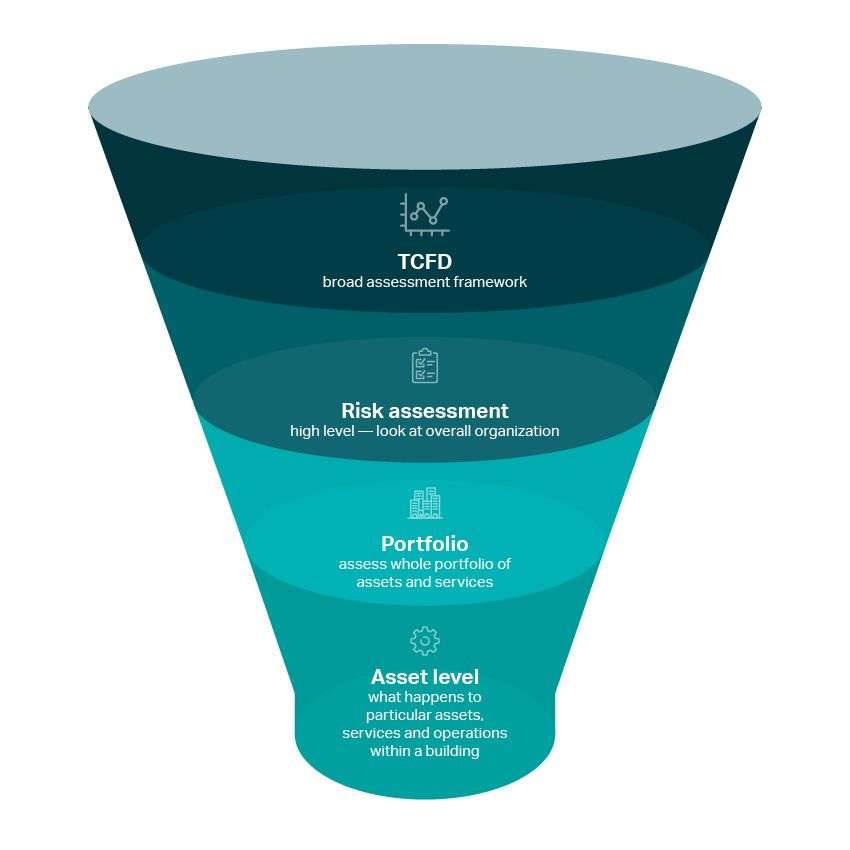
Climate change resilience: actionable steps to improve your organization's response
Climate change resilience is a rising priority, and with increasingly frequent and severe hazards and events, organizations must be prepared to respond and adapt.

MIT refers to climate resilience as “how well something withstands, and how quickly it recovers from, natural hazards made worse by climate change.” With the OECD defining climate resilient infrastructure as having the defining characteristic of being “ planned, designed, built and operated in a way that anticipates, prepares for, and adapts to changing climate conditions.” and “can also withstand, respond to, and recover rapidly from disruptions caused by these climate conditions.”
Resilience is a global challenge requiring a localized response and preparedness. Different regions and territories are grappling with increasingly frequent and severe hazards and events. In Australia, AECOM is working with Australia’s Department of Defence to prepare and adapt its sites for resilience to climate change or in Massachusetts, USA, where we worked with the state to build their long-term resilience plan to projected climate changes.
Resilience isn’t just about buildings and infrastructure but nature too. We’re currently working with the Great Barrier Reef Foundation on five listed UNESCO World Heritage coral reef sites through the Resilient Reefs Initiative to develop a roadmap to reef resilience to combat the effects of climate change and other challenges.
As climate change accelerates, company boards can’t sit back and wait for the centralized emergency response. We have responsibilities as leaders to take ownership by instigating climate action now that lowers carbon, manages risk and adapts our activities for a more resilient future.
Resilience planning and preparedness
Organizations should be placing more emphasis on resilience planning and preparedness. This includes taking a whole systems approach that recognizes the underlying stresses, as well as the shock of an event itself, and covers multiple potential responses. Organizations can’t prepare for everything but can adapt and prepare a resilience response that identifies and addresses the operational risks to your organization.
Align resilience to TCFD
The Task Force on Climate-Related Financial Disclosures (TCFD) framework for reporting climate-related financial information has been adopted by many organizations as the voluntary standard to guide resilience work and to achieve climate resilience. The TCFD framework sets a consistent global approach by outlining a broad process for organizations to take. Governments including the UK and New Zealand are moving towards mandatory TCFD reporting as well as many private investors. For compliance, our clients are starting to ask for investment plans aligned with TCFD to use as evidence with their stakeholders and government. Climate resilience is the outcome they’re trying to achieve.
Resilience is about responding to multiple events
Previously resilience was about responding to a single event or hazard. This is no longer applicable. Regional governments and cities are acknowledging global events such as Covid 19 and climate change now require more agnostic resilience plans with initiatives responding to multiple and compounding hazards.
Getting started with resilience
1. Do a simple organization health check
To help you understand your organization's maturity to resilience. This will help identify the organizational context for managing climate risks. This includes the presence or absence of supporting policies, governance, leadership, stakeholder engagement, awareness of impacts and skills.
2. Conduct a high-level assessment
To get a feel for your resilience ‘hot spots’ across your assets and services. This high level assessment will help to understand how climate change may impact organizational objectives. It will also identify delivery areas of the organization that are particularly exposed and warrant a more detailed risk assessment.
3. Use materiality assessments to see how mature your organization is to respond
Use your materiality assessments to understand your response to climate risks and to identify where to focus most of your efforts. This will help organizations to understand their adaptive capacity and sensitivities, as well as identify any current barriers and enablers within the organization to increasing building resilience.
4. Turn your high level to assessment into reality already on the ground
To get organizational buy-in for resilience – find and share examples from key stakeholders staff about what’s already been happening. Supply chain issues, operational disruptions, transport access risks, where are those pressure points already being experienced? When identifying the most relevant stakeholders, it is useful to consider diversity of perspectives and experience, representativeness, relevant expertise, their ability to influence the process, and their proximity to potential risks.
A practical guide developed by AECOM to assess and manage climate change risks is also available.
A scalable approach for organizational resilience
For organizations to create their resilience response we advise the following process:

Preparing for change
As sea levels rise, communities are forced to make near and long term decisions about how – and if – they should invest in adaptation. In Florida, we are worked with the Southeast Florida community to develop the regional business case for resilience. We found that community-wide adaptation strategies would bring in 2:1 return on investment, with a 4:1 return on building level adaptation strategies.
Resilience is a continuous cycle
Organizations often think resilience is about getting to a final end point, but you just can’t, as there is no endpoint. Resilience is a continuous cycle of qualities and characteristics that ebbs and flows as your organization and the world adapts and changes over time. The intrinsic behaviours include adaptability, flexibility, redundancy as well as self-regulation which is how you respond to an event and self-management that centres on how your organization proactively manages the situation.
Manage what you control
To manage climate resilience risks, we advise leaders to largely focus on managing what you can control and influence within the boundaries of your own operations. For example, at Hong Kong International Airport we ran an assessment using climate projections up to 2100 so our client could understand their risk exposure to more frequent and intense events such as typhoons. Although focusing on what you control in the first instance is a good start, it is important to understand the whole of system and the roles of other players that have an influence on your organization operations.

For more topical insights from our global network of expert ESG advisors, sign up to get The ESG Advisor every month direct to your inbox.



